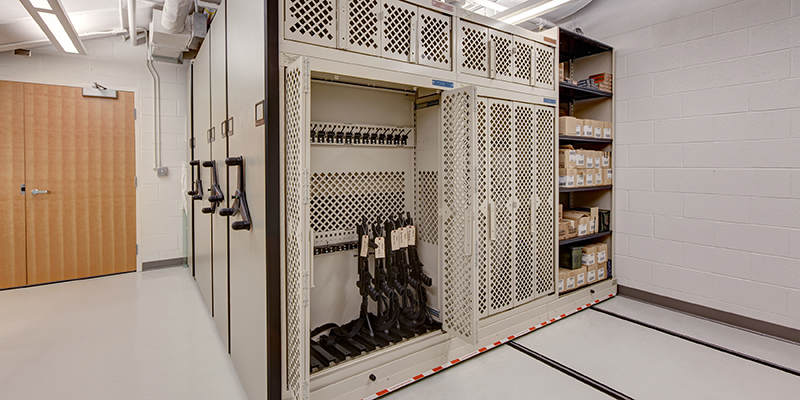Operational readiness doesn't start on the battlefield. It starts in the armory.
When weapons and gear aren’t accounted for or accessible, delays stack up, and missions risk falling apart before they begin. That’s why dependable, well-designed military armory storage systems are so critical. They give teams the tools to manage inventory with precision, whether they’re operating on base, in transit, or in active deployment.
As military operations have grown more advanced, so have the demands on the armory. Today’s weapons and tactical gear require storage that is just as precise and adaptable as the equipment itself. Armory managers need systems that help them maintain control, ensure chain-of-custody, maximize limited space, and meet strict security protocols.
From high-density shelving to 4-post solutions, weapons racks, and specialized gear lockers, modern storage plays a critical role in keeping operations organized and mission-ready.
Challenge 1: Security is Non-Negotiable
A compromised armory can put entire missions or bases at risk. That's why the military armory follows strict security protocols to safeguard arms and munitions.
For the Army, AR 190-11 outlines the physical security requirements for arms, ammunition, and explosives, including proper use of arms racks and secure storage. In the Navy, OPNAVINST 5530.13D serves a similar purpose, establishing clear protocols to prevent unauthorized access or loss. Meeting these standards isn’t an option. It’s a requirement.

That’s why so many military armories turn to the Universal Weapons Rack (UWR) by Spacesaver. Designed with input from active-duty personnel, the UWR offers secure, modular storage for rifles, sidearms, optics, gear bags, you name it — all using a common cabinet frame. Its stackable design helps maximize space without compromising security.
The system comes in a variety of sizes to fit different needs, from the compact 18” UWR Mini to fully welded, heavy-gauge steel cabinets ranging from 45” to 84” in height. Built-in locking bars and retractable doors support compliance, while the diamond-perforated mesh exterior makes it easy to confirm inventory.

To protect weapons in transit, UWRs are engineered to absorb shock and reduce vibration. Each rack is either dipped in black PVC or constructed with injection-molded thermoplastic, both designed to minimize wear and tear and prevent abrasion during storage or movement.
Challenge 2: Space is Always a Constraint
Military armories don’t get to expand just because inventory does. As personnel increases and equipment evolves, the space you’re working with usually stays the same. That’s why designing a centralized, efficient storage hub is so important: You can get more done without needing more room.
From new gear to updated mission requirements, the list of what needs storing is always growing. Staying organized without sacrificing accessibility takes thorough planning. That means prioritizing layout, inventory control, equipment access, and long-term maintainability right from the start.

Whether you’re using cabinets, weapon racks, crates, or wall-mounted storage, there’s a solution that can help maximize capacity while keeping everything secure, visible, and easy to manage.
High-density storage systems can help free up personnel and space for other mission-critical tasks. By consolidating weapons, gear, and equipment into a compact, secure layout, mobile shelving can double your usable storage footprint without sacrificing ability or workflow.

Pairing mobile carriages with four-post shelving, bins, or weapon racks makes it easier to issue gear and retrieve items quickly. These systems run on rails and can be operated manually, mechanically, or with powered controls, allowing aisles to open when needed and close to reclaim valuable floor space when not.
Challenge 3: It's More Than Just Guns
Weapons may be the headline, but military armories manage much more than firearms and ammunition. Tactical gear, communications equipment, optics, body armor, and maintenance supplies all fall under their purview, and each one is critical to operational readiness.
That range of gear brings its own challenges. Radios, helmets, night vision devices — every item has a different footprint, weight, and storage requirement. Many pieces also come with unique handling or protection needs, making generic shelving a non-starter.

This is high-value, precision equipment. It can’t be casually stacked or shoved into corners and shouldn’t be. Purpose-built storage helps protect sensitive gear, expand its lifespan, and ensure it’s always mission-ready when needed.
Custom military storage solutions can help armories operate with precision and accountability. The right setup can:
- Improve security and control, reducing the risk of theft or misuse
- Support regular inspections, ensuring gear stays operational and deployment-ready
- Protect equipment from wear and tear, reducing the risk of malfunctions in the field
- Save time and money by making inventory easier to find (and harder to lose)
A well-organized armory keeps units moving, whether in day-to-day operations or gearing up for deployment. Modular 4-post shelving offers flexibility for storing everything from field rations to bunk rolls. Add doors, dividers, or drawers to tailor each shelf to your needs. And when needs change, universally slotted shelving makes it easy to adapt without starting over.
That same modular flexibility applies to UWRs. You can add accessories to store tactical gear, like optics, attachments, or spare barrels, right alongside secured firearms. Cabinets can be configured with vertical or horizontal bins to hold ammo clips, boxes, and other essentials. And you can swap out or adjust bins quickly, without tools or fasteners.

Spacesaver’s Tactical Readiness Locker takes that same principle even further. Built for durability, ventilation, and secure access, these lockers are ideal for storing bulky gear like helmets, armor packs, or communication kits. A wide range of interchangeable parts makes it easy to reconfigure the system as storage needs change, all in the same footprint.
Mission-Ready Armory Storage
Military armory personnel have a tall order: meet strict security standards, manage limited space, and keep track of gear that comes in every shape and size (and no, juggling isn't recommended — especially not with the grenades.) Storage needs to be durable, flexible, and built to handle pressure. Just like the soldiers who rely on it.
Ready to rethink your military armory setup? Contact a Patterson Pope representative today.




















